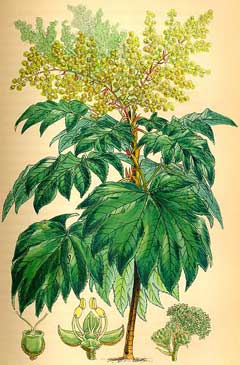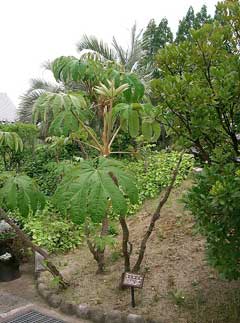 |
|
http://commons.wikimedia.org/wiki/File:Rice_Paper_Plant-Fitch.jpg |
 |
| http://commons.wikimedia.org/wiki/User:KENPEI |
Translate this page:
Summary
Bloom Color: White. Main Bloom Time: Early fall, Late fall, Mid fall. Form: Rounded, Upright or erect.
Physical Characteristics

 Tetrapanax papyrifer is an evergreen Shrub growing to 5 m (16ft) by 5 m (16ft) at a fast rate.
Tetrapanax papyrifer is an evergreen Shrub growing to 5 m (16ft) by 5 m (16ft) at a fast rate.
See above for USDA hardiness. It is hardy to UK zone 8 and is frost tender. It is in leaf all year, in flower in August, and the seeds ripen from October to December. The species is hermaphrodite (has both male and female organs) and is pollinated by Bees.
Suitable for: light (sandy), medium (loamy) and heavy (clay) soils. Suitable pH: mildly acid, neutral and basic (mildly alkaline) soils. It can grow in semi-shade (light woodland) or no shade. It prefers moist soil.
UK Hardiness Map
US Hardiness Map
Synonyms
Aralia papyrifera. Fatsia papyrifera.
Plant Habitats
Woodland Garden Sunny Edge; Dappled Shade; Shady Edge; South Wall. By. West Wall. By.
Edible Uses
Edible Parts: Root
Edible Uses:
Root[105, 177]. No more details are given.
References More on Edible Uses
Medicinal Uses
Plants For A Future can not take any responsibility for any adverse effects from the use of plants. Always seek advice from a professional before using a plant medicinally.
Diuretic Febrifuge Galactogogue Sedative Vermifuge
The pith is deobstruent, diuretic, febrifuge, galactagogue, sedative and vermifuge[147, 218]. It is used in Korea in the treatment of oedema[279].
References More on Medicinal Uses
The Bookshop: Edible Plant Books
Our Latest books on Perennial Plants For Food Forests and Permaculture Gardens in paperback or digital formats.

Edible Tropical Plants
Food Forest Plants for Hotter Conditions: 250+ Plants For Tropical Food Forests & Permaculture Gardens.
More

Edible Temperate Plants
Plants for Your Food Forest: 500 Plants for Temperate Food Forests & Permaculture Gardens.
More

More Books
PFAF have eight books available in paperback and digital formats. Browse the shop for more information.
Shop Now
Other Uses
Paper
The inner pith of the stems is used to make 'rice paper'[1, 46, 61, 171]. It is also used for making toys and flowers, for surgical dressings and for painting on[61]. The paper is made by cutting thin slivers from long sections of the pith[218].
Special Uses
References More on Other Uses
Cultivation details
Landscape Uses:Border, Container, Massing, Specimen, Woodland garden. Succeeds in any fertile soil[182, 200] and in most situations[200]. Prefers a moist but well-drained humus-rich soil in full sun or semi-shade[188]. The plant requires a sheltered position in order to prevent damage to its large leaves[260]. Plants are not very hardy outdoors in Britain and are normally best grown in a cool greenhouse[1], but in selected sites they can tolerate temperatures down to about -5°c[166, 200]. They are often cut back to ground level in cold winters but will normally regrow from the rootstock in the spring[200]. The plant can, in fact, become invasive, spreading by means of a vigorous suckering rootstock[200]. Plants are growing well at Menehay in Cornwall[59]. A young specimen was seen at Hilliers Arboretum in April 1999. It had about 3 years of growth above ground and was growing in a sheltered but fairly sunny position with no sign of die-back[K]. Even more established plants can be found growing by a south-facing wall against a greenhouse at Cambridge Botanical Gardens. They had at least 4 years of growth above the ground in spring 1999 and were spreading at the roots[K]. Plants are much cultivated in China for the pith obtained from the stems, which is used to make 'rice paper'[46, 266]. A very ornamental plant[200], it is closely related to Fatsia japonica[182]. The flowers are produced in autumn and are often damaged by frosts[182]. Special Features:Attractive foliage, Not North American native, Naturalizing, Attractive flowers or blooms.
References Carbon Farming Information and Carbon Sequestration Information
Temperature Converter
Type a value in the Celsius field to convert the value to Fahrenheit:
Fahrenheit:
The PFAF Bookshop
Plants For A Future have a number of books available in paperback and digital form. Book titles include Edible Plants, Edible Perennials, Edible Trees,Edible Shrubs, Woodland Gardening, and Temperate Food Forest Plants. Our new book is Food Forest Plants For Hotter Conditions (Tropical and Sub-Tropical).
Shop Now
Plant Propagation
Seed - sow autumn in a greenhouse[200]. Prick out the seedlings into individual pots when they are large enough to handle and grow on for at least their first year in the greenhouse. Plant out in late spring or early summer, after the last expected frosts. Consider giving the plants some protection from winter cold for their first few years outdoors[K]. Division of suckers in the early spring. They can be difficult to establish[200]. It is probably best to pot up the divisions and grow them on in light shade in a greenhouse until they are well established. Keep them in the greenhouse for their first winter then plant them out in late spring or early summer, after the last expected frosts.
Other Names
If available other names are mentioned here
Native Range
TEMPERATE ASIA: Japan (Ryukyu Islands), Taiwan
Weed Potential
Right plant wrong place. We are currently updating this section.
Please note that a plant may be invasive in one area but may not in your area so it's worth checking.
Conservation Status
IUCN Red List of Threatened Plants Status :

Growth: S = slow M = medium F = fast. Soil: L = light (sandy) M = medium H = heavy (clay). pH: A = acid N = neutral B = basic (alkaline). Shade: F = full shade S = semi-shade N = no shade. Moisture: D = dry M = Moist We = wet Wa = water.
Now available:
Food Forest Plants for Mediterranean Conditions
350+ Perennial Plants For Mediterranean and Drier Food Forests and Permaculture Gardens.
[Paperback and eBook]
This is the third in Plants For A Future's series of plant guides for food forests tailored to
specific climate zones. Following volumes on temperate and tropical ecosystems, this book focuses
on species suited to Mediterranean conditions—regions with hot, dry summers and cool, wet winters,
often facing the added challenge of climate change.
Read More
Expert comment
Author
(Hook.)K.Koch.
Botanical References
200266
Links / References
For a list of references used on this page please go here
Readers comment
© 2010, Plants For A Future. Plants For A Future is a charitable company limited by guarantee, registered in England and Wales. Charity No. 1057719, Company No. 3204567.